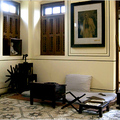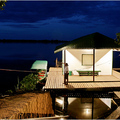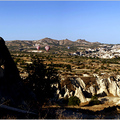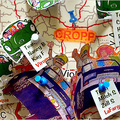An Adriatic Stretch Is Awaiting Its Riviera Moment
THE British writer Rebecca West once called Budva, the largest and northernmost city on the Montenegrin Riviera, “a little white tortoise against the blue sea.” Not much has changed over the course of two wars, a Communist regime and almost 70 years since she wrote that: Budva is still a white-walled jewel jutting into the glass-clear Adriatic Sea, a dramatic entry point to the miles of beaches that stretch south toward the Albanian border. Along its lee side lies a small harbor stocked with fishing and pleasure boats; along its seaside runs an imposing Venetian fortress.
With its narrow stone streets and expansive sea views, Budva reminds many visitors of Dubrovnik, its tourist-choked Croatian neighbor 60 miles north. And Montenegro, having seen what a little tourism can do for an ex-Communist economy, is eager to cash in on the similarities. Though not yet a member of the European Union, it has already adopted the euro as its official currency, the better to draw wealthy Western Europeans. Hotel staff members wear neatly pressed uniforms and speak perfect English. And everywhere roads are being widened, wineries are sprouting and luxury resorts are opening for business — at a steep discount from even Croatia’s tourist fare, let alone France’s or Italy’s.
The old city of Budva teems with shops, restaurants and bars, interposed with the occasional church-fronted plaza. The town (according to legend founded by Cadmus and Harmonia, but more likely settled in the fifth century B.C. by Greek colonists) and its environs abound with ruins, primarily Roman, including thermae uncovered by a 1979 earthquake. The newer parts of the city are not much to look at beyond the beach, although in fairness it’s hard to tell for all the construction and roadwork.
To avoid the crowds, you can head southeast a mile or two to a new strip of luxury hotels rising along Becici’s beach, including the four-star Queen of Montenegro, where a little over 100 euros a night will fetch a balconied room overlooking the Adriatic. The hotel, majority-owned by an Austrian concern, is the result of a rush by international investors to cash in on the Montenegrin coast’s growing popularity. Just up the road is the Hotel Splendid, built by a Russian company; meanwhile, a Singaporean company has plans to renovate Sveti Stefan, a fishing-village-cum-hotel — once luxe, now down at the heels — on a small peninsula a few miles south of Budva.
Montenegro has seen all of this before. During the height of Communist Yugoslavia, Belgrade poured money into its coast as a way of attracting domestic and international tourists. The real draw was Sveti Stefan, which opened in the 1950s after officials converted its cottages into luxury suites and its plazas into exclusive alfresco restaurants.
Over the next several decades people like Sophia Loren, Richard Burton and Elizabeth Taylor paid a visit, and it was rumored to be the destination of choice for Charles and Diana’s honeymoon (until press attention forced the couple to change plans). The complex essentially shut down during the Balkan wars, but its new operators have plans to reopen it in its former glory sometime in the next few years.
Becici, at least in the off-season, is still mostly a local hangout. English menus are fewer, and a little Serbo-Croatian goes a long way in negotiating dinner. Running along the beach is a promenade of restaurants and bars, and on a recent visit I watched from my sidewalk table at a beachside tavern as a small army of local high school students paraded by, duded up in tuxes and ball gowns, their destination unclear.
Budva is also a good base from which to set out on day trips down Montenegro’s coast and into its mountainous interior. The two-lane “Adriatic Highway” running south to the Albanian border isn’t the best road, especially when you’re stuck behind slow-going trucks, but the scenery is a good diversion. Wrapped alongside a steep slope rising straight up from a rocky coastline, the road is akin to the more dramatic parts of California’s Route 1, but dotted with Orthodox monasteries and roadside markets.
Like elsewhere along the Adriatic coast, nearly every stari grad (old city) is a former port. One exception is Bar, the oldest portion of which sits a few miles inland and uphill from its bustling modern seaside. Destroyed in the same earthquake that uncovered ruins in Budva, old Bar is now uninhabited and overgrown; the locals have installed historical exhibits in some of the still-standing buildings and charge a euro to enter, with proceeds going to renovation.
As I wandered, I met a Russian couple who seemed to like Bar the way it was. In a grassy courtyard overlooking the coast, Marina Lazareva was drawing sketches of the town to take back to Moscow, where she would use them in making mezzotints and watercolors. It’s the light, said Vladimir, her husband and interpreter. “We came here last year, and we want to come again next year.”
Another good day trip is Lake Skadar. Ringed by thousands of acres of marsh grass and populated by flocks of black ibises, the lake seems a thousand miles from the sandy beach, instead of just seven. The southern reaches of the lake are in Albania, but about two-thirds of the northern shoreline is Montenegrin and constitutes a national park.
Just north of Budva lies the Boka Kotorska, a T-shaped fjord between the Riviera and the Croatian border. Half a dozen somnolent towns occupy the thin strips of flat land between the calm water and the mountains that cup it, including the bay’s namesake, Kotor, whose triangular stari grad is a Unesco World Heritage Site.
I stayed overnight in Kotor, dining on branzino at Restaurant Gallery, just outside the city walls, and sleeping at Hotel Marija, one of the few options in town (and fortunately a good one). Though still relatively untouristed, Kotor comes alive at night: a string of stone plazas overflow with enormous cafes that stay packed until the early morning.
Farther up the fjord is Perast, another old port legendary for its seamen. They fought under the Venetians at the Battle of Lepanto in 1571, and later Peter the Great of Russia sent some of his noblemen to the town to study at its maritime academy.
Little remains of Perast’s nautical fame, though along its pier dock a few boats that, for 3 euros, will take you out to a pair of islands in the middle of the fjord, St. George and Our Lady of the Rock, the latter artificially built in the 17th century as a place for leaders of the coastal towns to meet and work out their differences — a sort of United Nations in miniature.
From Perast it is only about two hours to the Dubrovnik airport. As I drove there to catch my flight home, I decided that Montenegro was best compared to a stage immediately before a play. The set is ready, the cast waits nervously in the wings. All that’s missing is the audience.
VISITOR INFORMATION
HOW TO GET THERE
Flights from New York to Podgorica, the capital, generally involve changing planes (and airlines) in Europe, and start at about $1,800 round trip for trips in August. Austrian Airlines runs regular flights from Vienna for about $500. Montenegro Airlines also offers flights to Podgorica and Tivat, near Kotor, from Belgrade and other European cities. Shuttles are available from Podgorica and Tivat to Budva. An alternative is to fly to Dubrovnik, in Croatia, and rent a car, though there is often a surcharge for taking a car into Montenegro.
WHERE TO STAY
Montenegro still has a way to go before joining the European Union, but it has already adopted the euro as its currency.
The Queen of Montenegro (381-86-662-662; www.queenofmontenegro.com) is in Becici, outside Budva. Double rooms start between 55 euros (about $76 at $1.39 to the euro) and 110 euros a person, breakfast included, depending on the season.
Hotel Splendid (381-86-773-777; www.montenegrostars.com) is also in Becici. One of a trio of resort hotels in the area, it has double rooms starting at 97 euros to 137 euros a person, breakfast included, depending on the season.
In Kotor, I stayed at Hotel Marija (Stari Grad 449; 381-82-325-062). Doubles are 90 euros for two people, breakfast included.
WHERE TO EAT
Konoba Jadran (Slovenska Obala 10; 381-86-451-028) is a family-run local favorite, specializing in seafood.
Dolce Vita (Becicka Plaza 53; 381-67-317-544) offers quiet seaside dining a few miles south of Budva proper. Dinner with wine here, or at Konoba Jadran, will cost about 35 euros.
Masa (Gradska Luka; 381-86-453-777) in a enormous tented deck rising on a spit just east of the city walls, is a fantastic place to grab a drink (3 to 5 euros) or dessert (most are 3 euros) and watch the sun set over St. Nikola, an island just off the coast.







